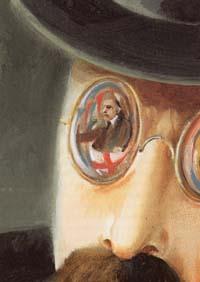|
Ulster will fight

Within Ireland, the
strongest opposition to home rule came from the Protestants of Ulster. They
formed a majority in the northern province, but a minority within the island.
The 1641 rebellion had induced a siege mentality which was reinforced during
the struggle between William of Orange and James II. Secret societies, agrarian
crime and faction fighting became common in the eighteenth century, with
Protestant Peep o' Day Boys pitted against Catholic Defenders. In 1795, a
pitched battle in County Armagh led to the formation of the Orange Order, which
soon mustered enormous support among Protestant labourers and small
farmers. In 1798, reports of sectarian
atrocities in County Wexford confirmed most northern Protestants, even those
who had risen in Antrim and Down, in a distrustful hostility towards Catholics.
Since the Union, Ulster had become much more prosperous than the
other provinces. Tenant farmers had greater security than elsewhere, had a
valuable cash crop in flax, and escaped the worst of the potato famine.
Industry flourished, and Belfast was a thriving port. However, after Catholic
emancipation, it was apparent that Protestants would be in a minority in any
all-Ireland parliament.
When Gladstone introduced his Home Rule Bill in 1886, his
Conservative opponents formed a political alliance with the Ulster Protestants
which was to last almost a century. "The Orange card was the one to
play", wrote a leading Conservative, Lord Randolph Churchill, who also
coined the watchword "Ulster will fight, and Ulster will be right."
The bill was greeted by severe rioting in Belfast. Sectarian violence was no
novelty in the city, but the 1886 riots were the worst the city had seen. There
were further disturbances in 1893, in response to Gladstone's second bill.
|
The Ulster Unionist Council was formed in 1905, linking the Orange
Order and Unionist associations throughout the province. It marked their
determination to keep the province within the Union, even if Protestants in the
rest of Ireland were ultimately forced to yield to nationalist aspirations. In
1910, Irish Unionism gained a new leader in Sir Edward Carson, an eminent
barrister and MP for Dublin University. Carson was prepared to defy the British
government and parliament. In 1911, he told a large rally on the outskirts of
Belfast to prepare to take over the government of Ulster if a Home Rule Bill
passed. On 28 September 1912, he was among almost half a million men and women
who signed a "solemn league and covenant" pledging themselves to use
"all means which may be found necessary to defeat the present conspiracy
to set up a home rule parliament in Ireland".
In 1913, the Ulster Unionist Council announced the formation of the
Ulster Volunteer Force. Some military drilling had already begun, and before
long 90,000 men had been recruited under the command of Sir George Richardson,
a distinguished soldier. They were poorly
equipped until the council commissioned a Belfast businessman, Major Fred
Crawford, to purchase arms secretly in Germany. In April 1914, 35,000 rifles
and five million rounds of ammunition were smuggled into Lame Harbour and
swiftly distributed throughout the province.

With home-rule legislation in abeyance during the First World War,
members of the Ulster Volunteer Force formed the 36th (Ulster) Division,
suffering heavy casualties at the battle of the Somme in 1916. In 1920, a new
Government of Ireland Act provided for a separate Northern Ireland parliament
covering six counties with a Protestant majority. The 1920 Act was never fully
implemented, and in 1922 the parliament in Belfast exercised its right to
exclude Northern Ireland from the newly created Irish Free State, and to remain
part of the United Kingdom. The partition of Ireland, so long implicit in the
contrast between Ulster and the rest of the island, became a reality.
|